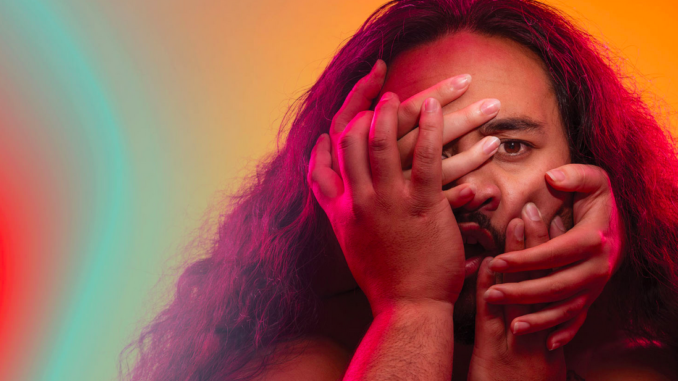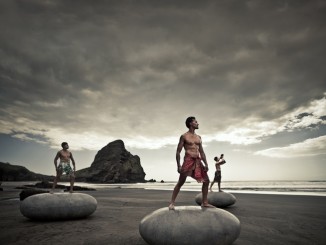
This collaboration between NZ Opera and Black Grace offers an intimate staging of Gluck’s 1769 opera Orpheus and Eurydice. The combination of Gareth Farr’s refined re-orchestration and Neil Ieremia’s guidance as both director and choreographer produces a largely accessible and compelling reimagining of the tragic Greek myth.
The most striking changes in Farr’s re-orchestration is that the harpsichord and timpani make way for marimba, and the harp disappears in favour of the modern man’s lyre – the guitar. The addition of these instruments does wonders in changing the tone of the work. Gone is the excessively formal and often florid plucking of the harpsichord. In its place the marimba offers both the percussive element of the timpani and the melodiousness of a string instrument. The marimba also has the added effect of producing an aural likeness to the Pātē, a Samoan slit drum, in that the sound is produced by striking wood. The introduction of a guitar then draws the work closer to the 21st century and for audience members unaccustomed to orchestral instruments offers an aural gateway into the composition.
Refining the orchestration to one which can be performed by a modern chamber ensemble has the added effect of highlighting the voices of particular instruments. This was particularly noticeable with the stringed instruments as there appeared to be just two violins in the orchestra pit. Having only a first and second violin allowed the listener to focus on the difference between the sections. At times the more melody focussed first violin danced above the supporting and often rhythmic second violin resulting in an overall lightness of touch.
This lightness carries over into the vocal performances of the three leads. Samson Setu’s performance of Orpheus is marked by control. His warm baritone is very measured, if a little too restrained. I found myself longing for a little more colour, or roughness as an expression of Orpheus’ anguish. As it was, the most impassioned Setu appeared was during the first choral piece of Act 1. Sung in Samoan and accompanied by images of communal mourning, Orpheus appears on a raised platform above the choir and dancers. The platform is populated only by a singular chair and a dark coloured car, parked front on to the audience. There, backlit and isolated both physically and by his grief, Setu as Orpheus performs a repetitive dance of longing and loss, striking his forearms, and heart, punctuated only by his cries of “Eurydice!”.
Eventually Orpheus is shaken from his melancholic meditation by the arrival of Amor. Madison Nonoa’s Amor is fun and youthful, and performed in a tilling soprano –an almost bird-like counterpoint to Setu’s grim Orpheus. Dressed in lurid red sock boots, space buns, and a cropped puffer jacket the character feels very much the imposter against an otherwise muted colour palette. My companion for the evening remarked upon the sense of ease and playfulness Nonoa exhibited and a little digging supplies the fact that this is not the first time Nonoa has performed the role of Amor, having previously sung as Amore in Orfeo ed Euridice for the Salzburg and Whitsun Festivals, and as Amour in Orphée et Eurydice with Raphaël Pichon and Ensemble.
Once Amor has set Orpheus on his path to the underworld, the fullness of designer Tracy Grant Lord’s vision is revealed. Until this point the structure supporting the platform on which Orpheus stands is obscured by two large floating panels of florally textured white or cream fabric. These panels are drawn away to reveal a striking inverted image of the ‘garage’ in which Orpheus has been located. Both the chair and the car are mirrored by upside down counterparts and Orpheus’ entry to this nether region is made by entering the car on the top level and exiting the vehicle on the underside of the platform. It is simultaneously a spectacular set piece and a deliciously simplistic representation of both worlds.
It is here, in the Stygian realm, that Deborah Wai Kapohe’s Eurydice resides. Wai Kapohe possesses a crystalline soprano voice, the clarity of which is made all the more impressive when considered against the rather dampening acoustics of the ASB Waterfront theatre main stage. It is only in the recitative that Wai Kapohe’s voice becomes a touch constrained. The arrival of the character of Eurydice introduces new tonal elements to the opera. The duet (Vieni, appaga il tuo consorte”/ Viens, suis un epoux”) between Eurydice and Orpheus is trippingly sweet and in this production became comedic as Eurydice, in her ignorance of the conditions of her release, blames Orpheus’ lack of desire to hold her hand on infidelity. While this garnered laughter from the audience it sits uneasily against the myth as a whole and one wonders if it is possible to further smooth over the gaps between the heightened and dramatic melancholy of Orpheus’ grief and what reads as a lovers’ trifling argument.
The singing of the duet in English undoubtedly adds to this sharp shift, as operatic singing in English always seems to clip and restrict the resonance of the voice resulting in a mixture of incomprehensibility and forced elongation. Make no mistake, Setu, Wai Kapohe, and Nonoa were in fine voice, this is merely a limitation of what can be offered by the English language. Comparatively the Samoan translations flowed off the tongue with considerably more ease than the English, and these two choral pieces were far more emotive and moving, heavy as they were in resplendent vowels.
This staging is greatly enhanced by the addition of a cohort of Black Grace dancers. Black Grace, as always, finds ways not only to express the inexpressible, but also to succeed in chronicling in movement the story beats as well as hinting at the inner states of the characters of Orpeheus and Eurydice. The dancers’ presence produces a doubling effect, as not only is the narrative and the sentiments of the opera communicated through the score but through the dancers’ bodies and movement of their clothing. I found myself watching the dancers in order to absorb the emotions portrayed rather than listening to the words being sung. This refocussing was encouraged by the fact that under Ieremia’s direction the distinction between ‘dancers’ and ‘choir’ is blurred at times. All performers were adept at moving with grace and passion, and the very fluid choreography offers yet another layer of enchantment and accessibility – serving to magnify elements of Gluck’s original work while cementing this staging in our particular Pacific context. One example of a context specific addition made possible by the presence of Black Grace and Ieremia’s direction is in the final choral piece in which the dancers and choir are joined in performing celebratory sasa in response to the return of Eurydice. This final choral moment was a triumph in staging and greatly heightened the narrative conclusion.
(m)Orpheus is an exciting project for NZO to present and I hope it leads to further creative partnerships and ambitious stagings.
(m)Orpheus played the ASB Theatre Auckland 6th-10th of September and The Opera House, Wellington 20th-23rd September 2023.


Leave a Reply